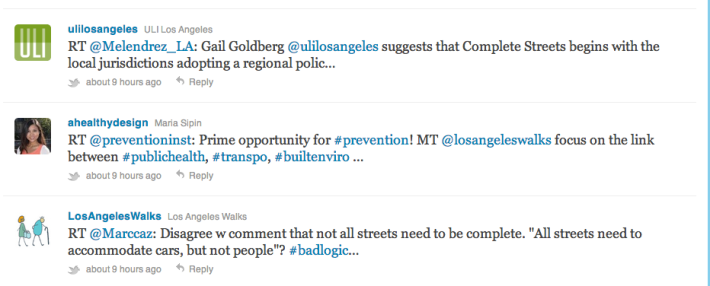Consensus Builds for Complete Streets as Metro Plans County-Wide Policy
8:30 AM PST on January 9, 2014
This video is pretty impressive in that it features over half of the Metro Board basically repeating Complete Streets talking points. You can find the rest of the materials from the meeting here.
At their Board Meeting this June, Metro will pass a Complete Streets policy in accordance with state law. While the first official hearings won't be held until later this year, the process was unofficially kicked off yesterday, with the Los Angeles County Active Transportation Collaborative Complete Streets Meeting held just north of Union Station, at the California Endowment.
The meeting was not just a choir-preaching session comprised of the usual suspects.
Packed to overflow capacity, the room held staffers from a number of local advocacy groups, including TRUST South L.A., Pacoima Beautiful, and Community Health Councils. The very Metro staff that will work on the Complete Streets policy were also in attendance. In addition, three Metro Board Members, Glendale City Council Member Ara Najarian, Santa Monica Mayor Pam O'Connor, and Mayoral Appointee Jackie Dupont-Walker, were joined by staff from the offices of Mayor Eric Garcetti and Metro Board Chair Diane Dubois.
By the time the conference was over, nearly everyone was in agreement that a forceful Complete Streets policy -- one with both teeth and incentives -- is needed in L.A. County.
"It appears we do have significant cities in the county which don’t have Complete Streets policies. We need to find ways to encourage those communities to come up with Complete Streets policies very quickly," said Dupont-Walker in a phone interview following the meeting. "We want policies that don't just penalize those that don't comply, but ones that provide incentives for those that do."
In this, L.A. County is somewhat behind in the game.
Most counties have already passed their laws in line with the Complete Streets Act of 2008, which requires all municipalities, counties, and regional governments to institute policies ensuring that transportation agencies design (or retrofit) roadways to accommodate all users. Such streets should have wide sidewalks, marked lane crossings for pedestrians, bicycle markings, and appropriate speed limits to support anyone that wants to use the street, not just those that wish to drive on it.
It hasn't always been smooth sailing. Even as the ink from the Governor Arnold Schwarzenegger's signing pen was drying, Dave Snyder, the Executive Director of the California Bicycle Coalition, warned that the effort to bring Complete Streets designs to California wasn't over. As always, the devil would be in the details.
But, with meetings to solicit public feedback in the works for February and April (dates TBD), Metro is now taking the lead in creating the L.A. County program.
Better known as the region's largest transit agency, Metro is also the state-designated Regional Transportation Planning Agency. As such, it is Metro's job to help regional cities come into compliance with state law on Complete Streets.
"LACBC is excited to see Metro step into its natural role as a transportation policy leader for Los Angeles County," writes Eric Bruins, the Planning & Policy Director for the Bicycle Coalition. "Walking and biking are implemented locally, but there's still a need for strong support, coordination, and funding at the county level to help cities build good projects. This policy will help Metro catch up with Caltrans, SCAG, and cities that are already doing Complete Streets, while setting an inclusive vision for L.A. County's transportation system."

While Metro has been somewhat reluctant to embrace this type of role in the past, staff and the Board of Directors appear to be excited about moving forward on Complete Streets. The Board's excitement is seen in the video at the top of this post and in yesterday's attendance. As for staff, you can hear the excitement in their voices.
Shahrzad Amiri, the Deputy Executive Officer, Countywide Planning & Development, spoke candidly about what needs to be done to create the best possible program.
"Our development of this Complete Streets plan is predicated on getting all the right people involved," she said in a phone interview. "We want a very open and transparent process."
When pushed as to what the policy could look like, however, neither Dupont-Walker nor Amiri wanted to get into specifics.
They both acknowledged that funding could be key, specifically with regard to how the policy will impact future funding for proposals akin to Measure R or Metro's annual Call for Projects funds. Alameda County will not consider funding a local government's transportation requests without a local Complete Streets program in effect. So, there is precedent for including Complete Streets mandates in funding formulas.
But, many in the room aren't as interested in the mechanisms that will bring about better streets as they are in the end results.
"We still need the basics in many areas," said Yvette Lopez, the Deputy Director of Pacoima Beautiful. "We need sidewalks that aren't breaking, crosswalks that keep pedestrians out of danger. We want to see a Complete Streets policy, but we also need to see our streets just work better for everyone."
Stay in touch
Sign up for our free newsletter
More from Streetsblog Los Angeles
Metro Board Funds Free Student Transit Pass Program through July 2025
Metro student free passes funded another year - plus other updates from today's Metro board meeting
Eyes on the Street: New Lincoln Park Avenue Bike Lanes
The recently installed 1.25-mile long bikeway spans Lincoln Park Avenue, Flora Avenue, and Sierra Street - it's arguably the first new bike facility of the Measure HLA era
Brightline West Breaks Ground on Vegas to SoCal High-Speed Rail
Brightline West will be a 218-mile 186-mile-per-hour rail line from Vegas to Rancho Cucamonga - about 40 miles east of downtown L.A. - expected to open in 2028




